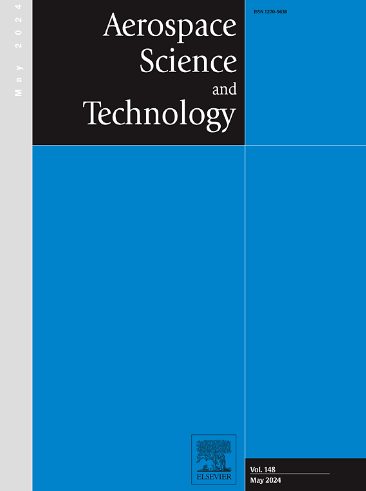Control allocation optimization for an over-actuated tandem tiltwing eVTOL aircraft considering aerodynamic interactions
IF 5
1区 工程技术
Q1 ENGINEERING, AEROSPACE
引用次数: 0
Abstract
This paper describes control allocation strategies for a tandem tiltwing electric vertical take-off and landing (eVTOL) aircraft with distributed propulsion. The control mappings are constructed as local surrogate models that relate the control effectors to the aircraft's aeropropulsive forces and moments across the full flight envelope, including interactional aerodynamics effects. Control allocation optimization problems are formulated based on force and moment commands for specific flight conditions. Specifically, a nonlinear programming formulation based on nonlinear control mapping is proposed for control allocation optimization, and the problem is solved using a sparse nonlinear optimizer. The solutions obtained from different formulations such as the minimization of force and moment residuals and the minimization of control effort are investigated. Furthermore, these solutions are compared with the solutions obtained using linear control mapping-based formulations. Results presented for the cases of forward flight, low speed flight & hover, and flight in the transition corridor suggest that considering aerodynamic interactions while formulating and solving the control allocation problem is necessary for higher levels of accuracy compared to linear approaches. One-propeller-out scenarios and moment and force generation cases are also investigated. Finally, control allocation for steady and accelerated operation in the transition corridor is discussed. The contribution of the methods and results in the paper is a nonlinear control allocation methodology for the entire flight envelope of an over-actuated tandem tiltwing eVTOL aircraft.
考虑气动相互作用的过驱动串列倾转翼 eVTOL 飞机控制分配优化
本文介绍了采用分布式推进的串列倾转翼电动垂直起降(eVTOL)飞机的控制分配策略。控制映射是作为局部代理模型构建的,它将控制效应器与飞机在整个飞行包线内的气动力和力矩相关联,包括交互气动效应。根据特定飞行条件下的力和力矩指令制定控制分配优化问题。具体而言,针对控制分配优化问题提出了一种基于非线性控制映射的非线性编程公式,并使用稀疏非线性优化器对该问题进行求解。研究了从不同公式中获得的解决方案,如力和力矩残差最小化以及控制努力最小化。此外,还将这些解法与基于线性控制映射的解法进行了比较。针对向前飞行、低速飞行 & 悬停和过渡走廊飞行等情况的结果表明,与线性方法相比,在制定和解决控制分配问题时考虑空气动力的相互作用对于提高精确度是必要的。此外,还研究了单螺旋桨脱离情况以及力矩和力的产生情况。最后,还讨论了过渡走廊中稳定和加速运行的控制分配问题。本文方法和结果的贡献在于为过驱动串列倾斜翼 eVTOL 飞机的整个飞行包线提供了非线性控制分配方法。
本文章由计算机程序翻译,如有差异,请以英文原文为准。
求助全文
约1分钟内获得全文
求助全文
来源期刊

Aerospace Science and Technology
工程技术-工程:宇航
CiteScore
10.30
自引率
28.60%
发文量
654
审稿时长
54 days
期刊介绍:
Aerospace Science and Technology publishes articles of outstanding scientific quality. Each article is reviewed by two referees. The journal welcomes papers from a wide range of countries. This journal publishes original papers, review articles and short communications related to all fields of aerospace research, fundamental and applied, potential applications of which are clearly related to:
• The design and the manufacture of aircraft, helicopters, missiles, launchers and satellites
• The control of their environment
• The study of various systems they are involved in, as supports or as targets.
Authors are invited to submit papers on new advances in the following topics to aerospace applications:
• Fluid dynamics
• Energetics and propulsion
• Materials and structures
• Flight mechanics
• Navigation, guidance and control
• Acoustics
• Optics
• Electromagnetism and radar
• Signal and image processing
• Information processing
• Data fusion
• Decision aid
• Human behaviour
• Robotics and intelligent systems
• Complex system engineering.
Etc.
 求助内容:
求助内容: 应助结果提醒方式:
应助结果提醒方式:


